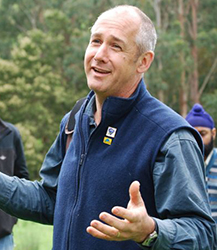Pruning trees for high quality sawlogs
Why and how to prune trees for sawlogs
Practical techniques by Rowan Reid
For a detailed Pruning paper look at Rowan's "The Principles and Practice of Pruning" which is available as a free download.
For a detailed Pruning paper look at Rowan's "The Principles and Practice of Pruning" which is available as a free download.
The Objective of Pruning
The aim is to confine the knots and other defects (pith, juvenile wood etc) to a central 'knotty core' (DOO - Diameter Over Occlusions <20cm) and have a wide sheath of knot-free 'clearwood' (CLW >20cm)around it which can be milled for high quality timber.

Rowan's standard pruning approach: Prune from the top down
Bearing in mind the many reasons for not having a fixed pruning 'recipe' below is my standard approach for pruning trees for clearwood sawlogs. I encourage growers to 'pune from the top down'. By this I mean starting by looking at the growing canopy and then down the stem:
1. Check every tree, every year to be sure that it is pruned on time (missing just one year can mean large branches and lower sawlog value)
2. Only pruning trees that are healthy and straight - cull trees that have excessive butt sweep or bends.
3. Remove any branch on the tree up to the anticipated log length (say 6.5m) that is over 2.5 cm in diameter - this will eliminate problems of double leaders and large branches early before they can affect the form of the tree and while they are still easy to remove.

4. Remove all branches up to the point where the stem is 8cm in diameter. Use a caliper made of plywood as a guide.

5. Having selected a straight tree for pruning don't bother pruning any adjacent trees within a distance equal to 30 times the tree diameter. For example, having pruned a tree than is 15cm in diameter don't prune any trees withing 4.5m. Unpruned trees should be thinned because they will compete with the pruned trees. If you prune them you a wasting time and competition will slow growth.
6. Repeat this process every year until you have achieved a clear, straight pruned stem up to the anticipated log length. I prune eucalypts to 6.5 metres in anticipation of a 6.1m sawlog.
Where to cut:
Be sure not to cut into the collar at the base of the branch. The easiest way to avoid this is to cut perpendicular to the branch. This mimics the text-book cut (A-B in the diagram).
Variable lift pruning
Pruning up to a fixed stem diameter (I prune most species up to where the trunk diameter is 8cm) ensures that every tree is pruned to the same degree. If you are pruning every tree to the same height (rather than diameter) you are probably overpruning the small trees and underpruning the large ones. Variable lift pruning leaves the same amount of canopy on every tree.
Pruning safely
For high pruning I use a pole belt and vertical ladders that can be tied to the tree. The belt is fastened around the tree before I leave the ground. When working above 2 metres you must be restrained. Others prefer to use pole saws and work from the ground. If you have flat land you can use orchard pruning lifts. Whatever you do - think saftey!
NOTE: Rules vary in each state: For Victorian Worksafe guide on falls prevention for farm forest pruning CLICK HERE

Rowan pruning a Sugar Gum for knot-free timber using a vertical ladder. pole belt, loppers, folding saw and helmet.
Extract from Heartwood: The art and science of growing trees for conservation and profit by Rowan Reid More on the book: LINK
For more information on pruning and thinning for timber check out my other publications.


